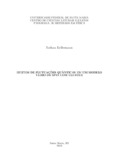| dc.creator | Kellermann, Nathan | |
| dc.date.accessioned | 2019-12-16T14:42:34Z | |
| dc.date.available | 2019-12-16T14:42:34Z | |
| dc.date.issued | 2019-05-29 | |
| dc.identifier.uri | http://repositorio.ufsm.br/handle/1/19156 | |
| dc.description.abstract | In this work we study the effects of quantum fluctuations in a disordered magnetic system.
We consider a cluster-spin Ising model with antiferromagnetic short range interactions (J0)
and disordered long range interactions (J) between clusters, where the system is under
the influence of a transverse magnetic field Γ. The analytic treatment of the model is
done by the replica method and Trotter formalism, in which a cluster mean field, replica
symmetric and static approximations are used. This allows us to obtain an effective model
of a single cluster that is exactly diagonalized. Thermodynamic quantities like order
parameter and free energy are obtained then, the phase diagrams are analyzed. They are
shown in temperature versus J0=J phase diagrams for some intensities of Γ. With Γ = 0,
when we decrease the temperature (for lower intensities of J0=J) a continuous phase transition
between the paramagnetic and cluster spin glass state (CSG) is found. When we
increase the ratio J0=J, the system presents the antiferromagnetic phase (AF). The CSG
state and the AF phase are separated by first order transitions. In the intermediate region
of disorder, there exist a small interval in the AF-PM transition that is first order. When
Γ is increased, the transitions PM-AF and PM-VSC decrease toward critical points in
the lower and higher disorder, respectively. It is worth to note, in the intermediate range
of disorder, that the transition CSG-AF disappears, letting a PM phase between them,
even for zero temperature. Besides that, the first-order region, in the PM-AF transition,
turns into a second order phase transition, changing its criticality in the low temperature
regime. Our results show that quantum fluctuations affects the phase transitions of the
model being capable to suppress and/or change his criticality. The present work suggests
a model and a mechanism of the change in the criticality away from the quantum critical
point, helping the investigation of this interesting and recent topic. | eng |
| dc.description.sponsorship | Conselho Nacional de Pesquisa e Desenvolvimento Científico e Tecnológico - CNPq | por |
| dc.language | por | por |
| dc.publisher | Universidade Federal de Santa Maria | por |
| dc.rights | Attribution-NonCommercial-NoDerivatives 4.0 International | * |
| dc.rights.uri | http://creativecommons.org/licenses/by-nc-nd/4.0/ | * |
| dc.subject | Desordem | por |
| dc.subject | Flutuações quânticas | por |
| dc.subject | Transições de fase | por |
| dc.subject | Disorder | eng |
| dc.subject | Quantum fluctuations | eng |
| dc.subject | Phase transition | eng |
| dc.title | Efeitos de flutuações quânticas em um modelo vidro de spin com cluster | por |
| dc.title.alternative | Quantum fluctuations effects in a cluster spin glass model | eng |
| dc.type | Dissertação | por |
| dc.description.resumo | Este trabalho analisa os efeitos de flutuações quânticas em um sistemas magnético desordenado.
Consideramos um modelo de spins de Ising divididos em clusters com interações
de curto alcance (J0) antiferromagnéticas e interações desordenadas de longo alcance (J)
entre clusters, onde esse sistema é submetido a um campo magnético transverso Γ. O
tratamento analítico do modelo é feito através do método das réplicas e do formalismo
de Trotter que, através da teoria de campo médio com clusters e das aproximações por
simetria de réplicas e estática, permite a obtenção de um modelo efetivo de um único cluster,
que é diagonalizado exatamente. Resultados de quantidades termodinâmicas como
parâmetros de ordem e energia livre são obtidos e, posteriormente, analisados em diagramas
de fases da temperatura versus a razão entre as interações AF e desordenada (J0=J)
para diversas intensidades de Γ. Para Γ =0, encontramos uma transição contínua da fase
paramagnética ao estado vidro de spin com cluster (VSC) quando a temperatura diminui
para desordens mais elevadas (baixas intensidades de J0=J). A partir de um certo valor
de J0=J, o sistema passa a apresentar a fase antiferromagnética (AF), que está separada
por uma transição de primeira ordem da fase VSC. Além disso, nesse regime de desordem
intermediária, existe uma pequena região da transição AF-PM que é de primeira ordem.
Quando Γ é intensificado, as transições de fase PM-AF e PM-VSC decrescem em direção
à pontos críticos quânticos nos regimes de baixa e alta desordem, respectivamente. É interessante
notar que, na região de desordem intermediária, a transição VSC-AF deixa de
ocorrer, sendo encontrada uma fase PM entre os estados VSC e AF, mesmo para temperatura
zero. Além disso, a região de primeira ordem em parte da transição AF-PM passa
a ser de segunda ordem, alterando a criticalidade do sistema para baixas temperaturas.
Nossos resultados mostram que as flutuações quânticas afetam as transições das fases presentes
no modelo, sendo capazes de suprimir e/ou alterar sua criticalidade. Nesse caso, o
presente trabalho sugere um modelo e um possível mecanismo causador da mudança na
criticalidade longe dos pontos críticos quânticos, podendo auxiliar na investigação desse
tópico interessante e recente. | por |
| dc.contributor.advisor1 | Zimmer, Fábio Mallmann | |
| dc.contributor.advisor1Lattes | http://lattes.cnpq.br/6328420212181284 | por |
| dc.contributor.referee1 | Costa, Francisco Alexandre da | |
| dc.contributor.referee1Lattes | http://lattes.cnpq.br/5307397723573993 | por |
| dc.contributor.referee2 | Maziero, Jonas | |
| dc.contributor.referee2Lattes | http://lattes.cnpq.br/1270437648097538 | por |
| dc.creator.Lattes | http://lattes.cnpq.br/2520597471773302 | por |
| dc.publisher.country | Brasil | por |
| dc.publisher.department | Física | por |
| dc.publisher.initials | UFSM | por |
| dc.publisher.program | Programa de Pós-Graduação em Física | por |
| dc.subject.cnpq | CNPQ::CIENCIAS EXATAS E DA TERRA::FISICA | por |
| dc.publisher.unidade | Centro de Ciências Naturais e Exatas | por |



